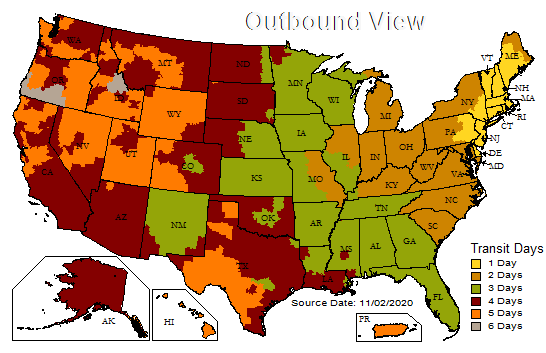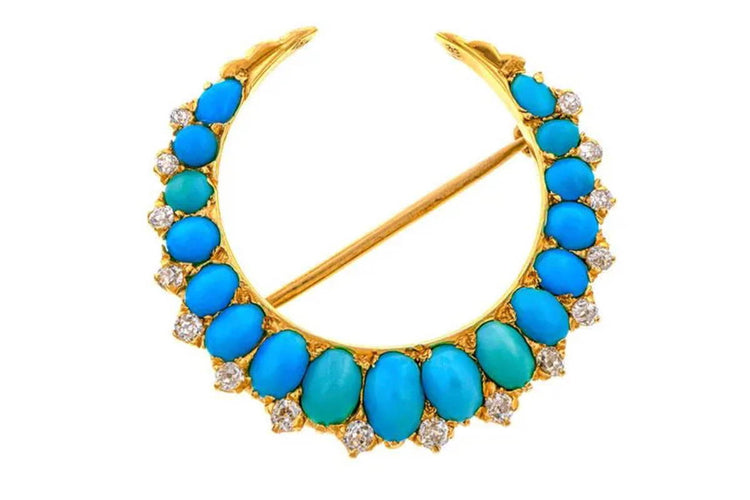Doyle & Doyle’s Victorian crescent moon with turquoise and diamonds, featured above
By Beth Bernstein
John Lennon’s lyrics “We All Shine On…Like The Moon, The Stars and The Sun” could have been attributed to these motifs in moon and stars jewelry throughout history. These iconic and symbolic emblems continue to shine in glimmering gold and sparkling diamonds or other precious stones. All three motifs date back to ancient civilizations and each have been associated with lore, legend, gods and goddesses in different cultures and time periods.
The period in which they began to be most popular in jewelry was in the 19th century, first in the Georgian period and then as icons in Victorian times that still hold the same meaning in modern jewelry. But before we jump ahead, let’s go way back and see what these symbols of the sky meant in earlier days.
Heavenly Bodies
The crescent moon dates back to second millennium BC and is the oldest symbol known to man. Both crescent moons and stars were first seen in in the civilizations around the Mediterranean Sea, Central Asia, and Persia.
In Southern Mesopotamia the star and crescent were attributed to gods and goddesses: the star (or Ishtar in Akkadian), was the Sumerian goddess of love, war, and fertility. The crescent was known as “Nanna” ( or Sin in Akkadian), the moon God.
Byzantine coins during the Greco-Roman period had crescent and star shapes on their obverse side. In later times, Emperor Constantine used the star and crescent symbol on these coins to dedicate the city of Constantinople to the Virgin Mary. Coins with different versions of crescent and star shapes were also present on coins during The Roman Empire.
The motifs were also popular during the Ottoman Empire, representing the moon god and sun god. This led to their association with Islamic religion and today they are still present on Islamic flags.
The sun as a symbol also dates back to antiquity. The ancient Greeks believed that the sun was a god named Helios. Selene, his sister, was the goddess of the Moon.
Enough with the background history, you want to know about the jewelry - the crescent moon necklaces, the moon and stars in earrings and brooches, the sun and moon charms - yes? Okay!
Symbolism In The Sky – A Look Back at Moon and Stars Jewelry
Fast forward to the Georgians and Victorian’s who were a sentimental lot. They weren’t allowed to express all of their emotions so they found ways of attributing symbolism to the pieces they gave as gifts to lovers and friends. One jewelry hallmark of the period were parures (suites of necklaces, bracelets) that often contained sun, moon and stars motifs, and were handed down in families who split them up between their children who appreciated the meaning and the beauty of these elements and the rare rare handmade pieces from which they came.
The crescent moons and stars were particularly popular during the later Georgian Period and were captured in silver moons and silver topped gold stars, set in a closed back with diamonds in collet settings. These were also in fashion during The Romantic Period—the early years of Queen Victoria’s reign - and then during the Aesthetic Period after she finally came out of her 20- year mourning for Prince Albert. It was at that time when jewelry became lighthearted and fanciful again.
Over The Moon – A Look at Modern Moon Charms
Crescent moons during the 19th century celebrated the feminine moon goddess and therefore was associated with female empowerment, which it still is today. It also symbolizes change and when it turns into a full moon it represents the ebb and flow of life. If there is a star attached or set in the same piece of jewelry as the crescent, it can be associated with the more romantic, “I love you to the moon and back.” Around the 1880s Victorian brides wore brooches with a crescent moon cradling a flower on their honeymoon. These sweet styles are called “honeymoon brooches,” representing “the magic of the moon and the sweet nectar of the flower.” These days, designers often take apart the moon and star jewelry such as the brooches to create charms or pendants.
Star Child – Looking at Shining Star Jewelry
While we are looking to the sky for symbolism, five-and seven-point stars are another powerful symbol to collect, representing guidance that is leading you in the direction you were meant to go. The Victorians also adopted the Eastern beliefs that the numbers five and seven bring luck and protection to their wearer. They also appear on compasses which guide and give you a sense of direction. Victorian stars often were accented with old cut diamonds for enduring love. They were sometimes set with moonstone centers for more positive vibes and to represent ‘the man in the moon’. Legend has it that moonstones brought good fortune to the wearer and kept them safe from harm.
Other powerful association with stars: Wishes, luck and attaining one’s dreams. This is where we get saying such as ‘wish upon a star’, “let this be your lucky star’ and “reach for the stars’.
Bagues au Firmament (Rings of the Heavens), were another way that jewelry depicted stars twinkling in the night sky. Old mine cut diamonds were set against deep blue enamel. Marie Antoinette was reported to have owned one of these rings.
Here Comes The Sun – Powerful Sun Charms
The sun was another powerful symbol throughout time, representing light and clarity and the life force. It is also associated with strength, energy and the power one can find within oneself. We see more sun motifs as we enter the Art Nouveau period and then again in the mid-20th century.
Reaching in to the 20th century; from Edwardian to that time when charms were having a heyday, French and U.S. jewelry markets saw the introduction of sun and moon charms that read “This be your lucky star” and “etoile d’amour” (Star of Love). They were yet another twist on the classic Sun, Moon and Stars jewelry theme.
The mid-twentieth century through the 70s also saw this trend move into all yellow gold with man in the moon lockets, sun god coin-discs and an update on compasses as medallions with stars in the center. The attention to the sky also morphs into the astrological from constellations to star signs
Sun, Moon and Stars Forever
The symbolism from the Georgian era and beyond is still being translated in magical and imaginative jewelry designs for the modern woman. At Monica Rich Kosann, our crescent moon necklaces and Sun, Moon and Stars charm necklaces and lockets are being styled to be worn alone or layered together. If they become part of your own jewelry story, please make a wish, feel empowered and live life to the moon and back.
Beth Bernstein is a jewelry historian, collector of period and modern jewelry and a purveyor of all things sparkly. She has penned three books—'My Charmed Life,' a memoir; 'Jewelry's Shining Stars,' a modern jewelry design coffee table book; and 'If These Jewels Could Talk,' an in-depth look at celebrities and the stories behind their legendary jewels on the silver screen and in real life—with a fourth one in the works. She has written and continues to write for major print and online magazines on all subjects pertaining to jewelry and style.




